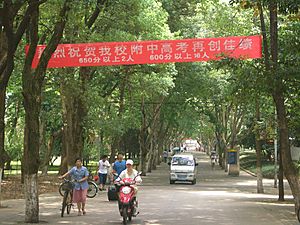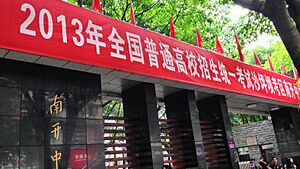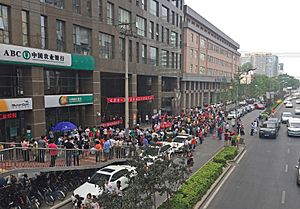Gaokao facts for kids
Quick facts for kids Gaokao |
|||||||||||||||||||||||||||||||||||||
|---|---|---|---|---|---|---|---|---|---|---|---|---|---|---|---|---|---|---|---|---|---|---|---|---|---|---|---|---|---|---|---|---|---|---|---|---|---|
| Simplified Chinese | 普通高等学校招生全国统一考试 | ||||||||||||||||||||||||||||||||||||
| Traditional Chinese | 普通高等學校招生全國統一考試 | ||||||||||||||||||||||||||||||||||||
|
|||||||||||||||||||||||||||||||||||||
| Higher education exam | |||||||||||||||||||||||||||||||||||||
| Chinese | 高考 | ||||||||||||||||||||||||||||||||||||
|
|||||||||||||||||||||||||||||||||||||
The National College Entrance Examination (NCEE), often called the gaokao (Chinese: 高考; pinyin: gāokǎo; literally "Higher Education Exam"), is a very important test in Mainland China. It's like the final exam for students who want to go to university. This test happens once a year.
Students usually take the gaokao in their last year of senior high school. The exams last about nine hours over two or three days. This depends on the province where the student lives.
Everyone must take exams in Chinese and Math. For the foreign language part, students can pick English, French, Japanese, Russian, German, or Spanish. Most students choose English.
Students also choose between two main paths:
- Liberal arts (文科倾向) includes History, Politics, and Geography.
- Natural science (理科倾向) includes Physics, Chemistry, and Biology.
Your total score is a mix of your subject marks. The highest possible score is usually 750 points. This can change a little each year and in different provinces.
The gaokao usually happens on June 7 and 8 every year. Sometimes, in a few provinces, it might last an extra day. Once, it was delayed because of COVID-19.
Contents
History of the Gaokao Exam

The very first gaokao exam was held a long time ago, from August 15 to 17, 1952. This was a big step for how students got into universities in China.
Over the years, the exam system changed a lot. In 1966, the gaokao was stopped for about ten years. During this time, students were chosen for college based on recommendations, not on test scores. Many young people also had to go work in the countryside.
In late 1977, a leader named Deng Xiaoping brought the gaokao back. This was a huge moment! The first exam after it came back had no age limit. So, many people, from teenagers to those in their late thirties, took the test. About 5.7 million people tried, but only a small number (less than 5%) got into university.
From 1978 onwards, the Ministry of Education started making the same exam for all students across the country. However, provinces later got to create their own versions of the exam. This started in Shanghai in 1985.
Today, it's much easier to get into university than in the past. But the gaokao is still very competitive. Students and their families feel a lot of pressure because this exam can really change a student's future.
Before 2003, the gaokao was held in July. It was moved to June to avoid hot weather and possible floods in southern China.
Gaokao in Recent Years
In 2006, a record 9.5 million students applied for university in China. Most of them took the national exam. A very small number (less than 1%) were excused if they were super talented in certain areas.
In 2017, about 9.4 million students took the gaokao. Around 7 million of them were accepted into colleges or universities. Getting into a top university (called "Yi Ben") was still quite hard, especially in provinces like Henan and Shanxi.
The exam subjects also change sometimes. For example, in 2017, some topics were removed from the elective parts of Math, Chemistry, Biology, History, and Geography. Physics had one elective course become compulsory.
In 2018, 9.75 million students took the gaokao.
How Many Students Get Accepted?
The number of universities in China has grown a lot since 1977. This means more students can now go to college.
Here's a quick look at how many students took the exam and how many were accepted over the years:
| Year | Number of Examinees | Accepted Students | Acceptance Rate |
|---|---|---|---|
| 1977 | 5,700,000 | 270,000 | 4.74% |
| 1978 | 6,100,000 | 402,000 | 6.59% |
| 1979 | 4,680,000 | 280,000 | 5.98% |
| 1980 | 3,330,000 | 280,000 | 8.41% |
| 1981 | 2,590,000 | 280,000 | 10.81% |
| 1982 | 1,870,000 | 320,000 | 17.11% |
| 1983 | 1,670,000 | 390,000 | 23.35% |
| 1984 | 1,640,000 | 480,000 | 29.27% |
| 1985 | 1,760,000 | 620,000 | 35.23% |
| 1986 | 1,910,000 | 570,000 | 29.84% |
| 1987 | 2,280,000 | 620,000 | 27.19% |
| 1988 | 2,720,000 | 670,000 | 24.63% |
| 1989 | 2,660,000 | 600,000 | 22.56% |
| 1990 | 2,830,000 | 610,000 | 21.55% |
| 1991 | 2,960,000 | 620,000 | 20.95% |
| 1992 | 3,030,000 | 750,000 | 24.75% |
| 1993 | 2,860,000 | 980,000 | 34.27% |
| 1994 | 2,510,000 | 900,000 | 35.86% |
| 1995 | 2,530,000 | 930,000 | 36.76% |
| 1996 | 2,410,000 | 970,000 | 40.25% |
| 1997 | 2,780,000 | 1,000,000 | 35.97% |
| 1998 | 3,200,000 | 1,083,600 | 33.86% |
| 1999 | 2,880,000 | 1,596,800 | 55.44% |
| 2000 | 3,750,000 | 2,206,100 | 58.83% |
| 2001 | 4,540,000 | 2,682,800 | 59.09% |
| 2002 | 5,100,000 | 3,205,000 | 62.84% |
| 2003 | 6,130,000 | 3,821,700 | 62.34% |
| 2004 | 7,290,000 | 4,473,400 | 61.36% |
| 2005 | 8,770,000 | 5,044,600 | 57.52% |
| 2006 | 9,500,000 | 5,460,500 | 57.48% |
| 2007 | 10,100,000 | 5,659,200 | 56.03% |
| 2008 | 10,500,000 | 6,076,600 | 57.87% |
| 2009 | 10,200,000 | 6,394,900 | 62.70% |
| 2010 | 9,460,000 | 6,617,600 | 69.95% |
| 2011 | 9,330,000 | 6,815,000 | 73.04% |
| 2012 | 9,150,000 | 6,888,300 | 75.28% |
| 2013 | 9,120,000 | 6,998,300 | 76.74% |
| 2014 | 9,390,000 | 7,214,000 | 76.83% |
| 2015 | 9,420,000 | 7,378,500 | 78.33% |
| 2016 | 9,400,000 | 7,486,100 | 79.64% |
| 2017 | 9,400,000 | 7,614,900 | 81.01% |
| 2018 | 9,750,000 | 7,909,900 | 81.13% |
| 2019 | 10,310,000 | 9,149,000 | 88.74% |
| 2020 | 10,710,000 | 9,675,000 | 90.34% |
| 2021 | 10,780,000 | 10,013,200 | 92.89% |
| 2022 | 11,930,000 | 10,145,400 | 85.04% |
| 2023 | 12,910,000 |
How Gaokao Works
The gaokao is not exactly the same everywhere in China. Each province of China or big city manages its own version of the exam.
Before the Exam Day
In the winter before the exam, students sign up. This is usually done online. They fill in their personal details and choose their elective subjects. Everyone must take Chinese, Math, and a foreign language (usually English). Then, they pick three more subjects from either science (Physics, Chemistry, Biology) or liberal arts (History, Geography, Political Science).
There are some basic rules for who can take the exam:
- You must follow China's laws.
- You need a high school diploma or something similar.
- You should be in good health.
- You must agree to the exam rules.
- There are special rules for foreign immigrants or students applying to military or police schools.
Some groups are not allowed to take the exam:
- Students already in higher education.
- Students with incomplete records.
- Anyone serving a prison sentence or facing legal action.
Before the gaokao, students also have medical check-ups. This is to make sure they are healthy enough for their chosen university major. For example, if you have poor eyesight, you might not be able to join a military school.
On Exam Day
The gaokao happens at the end of spring. All high school graduates across the country take it at the same time.
| Date | 7 Jun. | 8 Jun. | 9 Jun. | 10 Jun. | |||||
|---|---|---|---|---|---|---|---|---|---|
| Time | 9:00-11:30 | 15:00-17:00 | 15:00-16:40 | 8:00-9:30 | 11:00-12:30 | 15:30-17:00 | 8:00-9:30 | 11:00-12:30 | 15:30-17:00 |
| Subject | Chinese | mathematics | foreign language | physics | politics | chemistry | history | biology | geography |
| Score | 150 | 150 | 150 | 100 | 100 | 100 | 100 | 100 | 100 |
Getting into University
Your gaokao score is almost the only thing that decides if you get into university. If you don't do well, it's very hard to get in. Some students who don't pass the first time might repeat their last year of high school to try again.
Students apply to universities after they get their scores. They list their top choices. Universities usually accept students who put them as their first choice.
Changes to the Gaokao System
The subjects and how they are tested in the gaokao have changed over time. Before, students picked either "liberal-art" or "science" subjects, plus compulsory ones. Now, things are changing with a big reform that started in 2014.
"3+X" System
This system was used in many parts of China.
- "3" means three compulsory subjects: Chinese, Math, and a foreign language. Each is worth 150 points out of 750 total.
- "X" means students choose one more subject. This could be from Social Sciences (Politics, History, Geography) or Natural Sciences (Physics, Chemistry, Biology). This subject is worth 300 points.
- If you picked Natural Sciences, your Math test was a bit harder.
This system is slowly being replaced by newer ones.
Newer Systems: "3+1+2" and "3+3"
These newer systems give students more choices.
The "3+1+2" System
This system started in 2019 in several provinces.
- "3" is still Chinese, Math, and a foreign language (150 points each).
- "1" means you choose either Physics or History (100 points).
- "2" means you pick two more subjects from Chemistry, Biology, Politics, and Geography. These are called "Grading Exams" and are scored differently.
To make sure these "Grading Exam" scores are fair, they are changed into "band scores." This means your raw score is converted based on how well everyone else did. For example, a score in the top 17% might become a band score between 83 and 100.
The "3+3" System
This system has been used in Shanghai and Zhejiang since 2014. Other areas like Beijing and Tianjin also started using it.
- The first "3" is Chinese, Math, and a foreign language (like English, Japanese, etc.).
- The second "3" means you choose three more subjects from a list. This list includes Physics, Chemistry, Biology, Technology (in Zhejiang), Geography, Politics, and History. These are also "Grading Exams."
One idea behind this system was to let students focus on their strengths. However, sometimes students all pick the same "easy" subjects, which can make it hard for other subjects like Physics to have enough students.
Also, to take the gaokao, students first need to pass a "Qualifying Exam." This exam is usually easy, and you just need to pass it to show you have basic high school knowledge.
Challenges and Criticisms
The gaokao is very important, but it also faces some challenges.
Differences Between Regions
One big issue is that universities often accept more students from their home province. This means it can be harder for students from provinces with fewer universities to get in. For example, a student in Beijing might get into a top university with a lower score than a student from Jiangxi. This can make the competition even tougher for some students.
Because of this, some families even move to a different province just to give their children a better chance at university.
Migrant Children
Another problem is for children whose families have moved to a new province. Usually, you have to take the exam in the region where your family is officially registered. This can be hard for children of migrant workers. Some regions are starting to make it easier for these children to take the exam where they live and go to high school.
Special Help and Pressure
Some students get extra points or special help. This includes students from ethnic minority groups, foreign nationals, or children of military families. Students used to get bonus points for winning academic competitions or sports, but this has mostly stopped.
Because the gaokao is so important, students and teachers feel a lot of pressure. Teachers work hard to prepare students, often by having them memorize a lot of information and do many practice tests. This can sometimes mean less focus on creative thinking or students' feelings. Many students feel very stressed during the exam.
Impact of the Gaokao
The gaokao has a huge impact on the lives of most Chinese teenagers and their parents. It's seen as a major turning point that can decide a person's future path.
See also
 In Spanish: Gaokao para niños
In Spanish: Gaokao para niños
- Education in China
- Higher education in China
- List of universities in China
- Zhongkao



